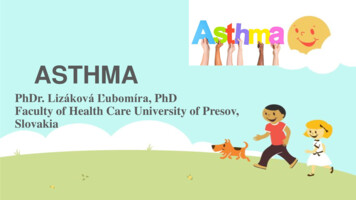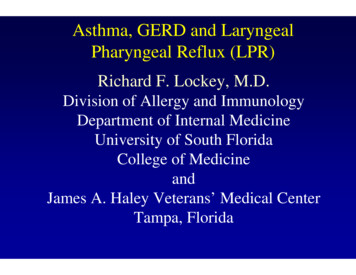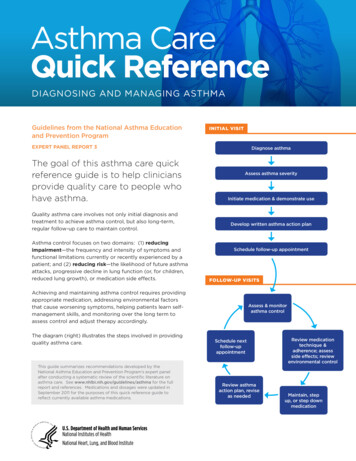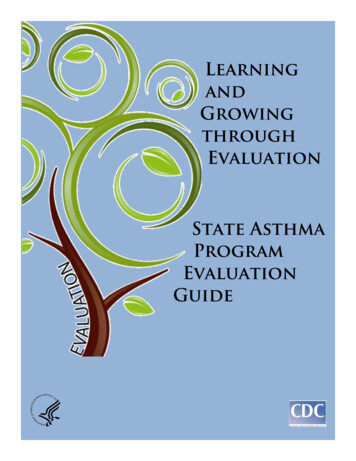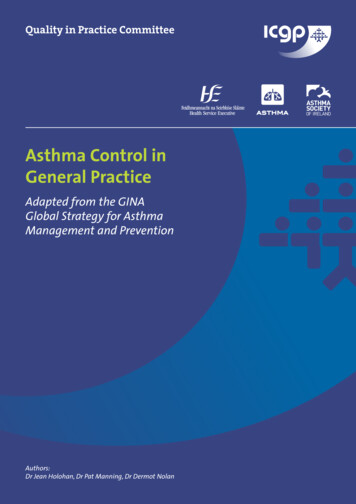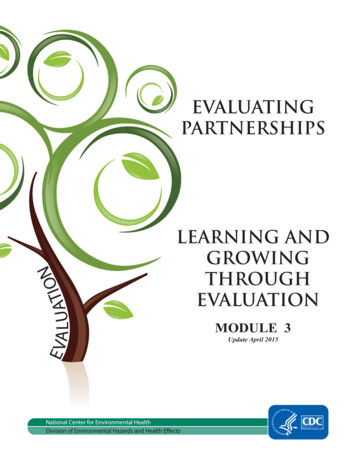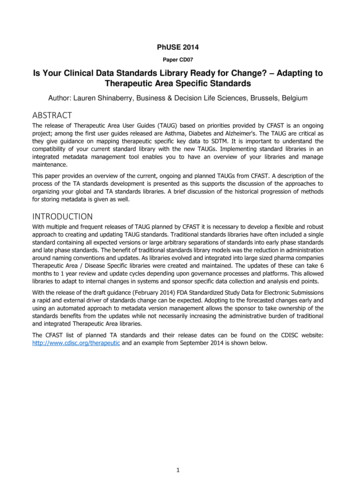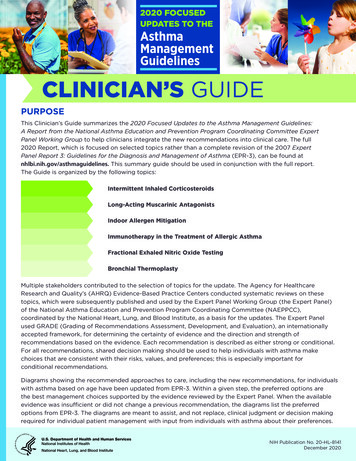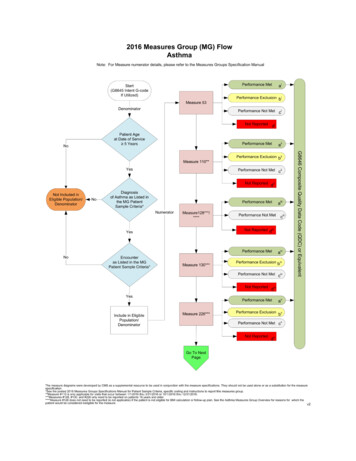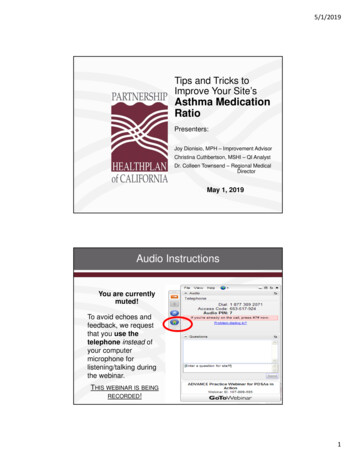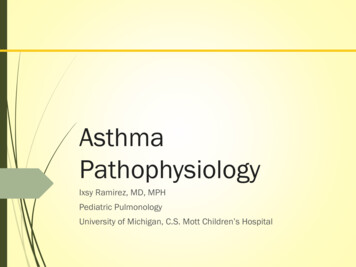
Transcription
AsthmaPathophysiologyIxsy Ramirez, MD, MPHPediatric PulmonologyUniversity of Michigan, C.S. Mott Children’s Hospital
Definition of Asthma Chronic inflammatory disorder of the airways Mast cells, eosinophils, T lymphocytes, macrophages,neutrophils, epithelial cells Causes variable and recurrent episodes ofwheezing, breathlessness, chest tightness,cough – especially at night or early morning Associated with widespread, but variable airflowobstruction that is often reversibleNHLBI Asthma Guidelines, EPR-3, Aug 2007
NHLBI Asthma Guidelines, EPR-3, Aug 2007
Asthma PathophysiologyIndividualInflammationGenetic predispositionIntrinsic vulnerabilityGene-environmentinteract:Atopy / allergyInfectionInflammation underlies diseaseprocessesPhenotype varies by individualand over timeImpactClinical symptoms also vary byindividual and over time
Airflow Limitation Induced by airway inflammation Bronchoconstriction- Bronchial smooth muscle contractionthat quickly narrows the airways in response to exposure to avariety of stimuli Airway hyperresponsiveness- an exaggeratedbronchoconstrictor response to stimuli Airway edema- as the disease becomes more persistent andinflammation become more progressive, edema, mucus hypersecretion, and formation of inspissated mucus plugs furtherlimit airflow.NHLBI Asthma Guidelines, EPR-3, Aug 2007
Pathophysiology
Pathology
Remodeling Reversibility of airflow limitation may be incomplete insome patients. Persistent changes in airway structure Sub-basement fibrosis Mucus hypersecretion Injury to epithelial cells Smooth muscle hypertrophy Angiogenesis
Histopathology of asthmaNormalAsthmaSame in both pictures (x 300) Tight structure with a predominance ofciliated epithelial cells. Only few goblet cells in the epithelium. The lamina propia, is practically cellfree. Inflammatory cells are not seen.Laitinen et.al. Allergy Proc 15,6:323, 1994 Less ciliated cells Goblet cells hyperplasia Epithelium and lamina propia arehighly infiltrated (mainly eosinophils andlymphocytes) Edema Basement membrane thickening Collagen deposition in the sub mucosa
Consequences of Remodeling inAsthmaSmoothmuscle ersistenceFibrogenicgrowth factorreleaseElastolysisReducedelasticity ofairway wallImportant mucussecretion tionCollagendeposition onRBM and ECMOngoinginflammationBousquet J, et al. Am J Respir Crit Care Med. 2000;161(5):1720-1745.
Histopathology of Status AsthmaticusIn fatal exacerbations the pathology is dominatedby extensive plugging of the conducting airwayswith mucus and extracellular debris
Changes in the Asthmatic AirwayInflammationSmooth pirationVolumeInspirationFEV1/FVC 75-80% Obstruction
Causes of Asthma Interplay between host factors (primarily genetics),and environmental exposures that occur at acrucial time in the development of the immunesystem. A definitive cause is unknown.
Causes of AsthmaNHLBI Asthma Guidelines, EPR-3, 2007
Clinical Heterogeneity of Asthma Allergic versus nonallergic asthma Late- versus early- onset asthma Exercise-induced asthma Nocturnal asthma Asthma with prominent symptom of cough
Pathogenesis of AsthmaNHLBI Asthma Guidelines, EPR-3, 2007
Asthma Pathophysiology –TherapeuticImplicationsShort andLong-ActingBeta2-Agonists Smooth onchial hyperreactivityHypertrophy/HyperplasiaInflammatory mediatorrelease Inflammatory cellinfiltration/activation Mucosal edema Cellular proliferation Epithelial damage Basement membranethickeningSymptoms/ExacerbationsAdapted from Bousquet et al. Am J Respir Crit Care Med. 2000;161:1720-1745.
Environmental Factors Allergens House dust mite Alternaria Cockroach/mouse Pets Infections Atopic interaction RSV, parainfluenza – young Rhinovirus Others Tobacco smoke Pollution/Occupation Obesity?
Natural History of Asthma - Children Majority of persistent asthma symptoms beginbefore age 3 Younger onset ( 3yo vs 6 yo) is associatedwith lower FEV1 at 11-16 yrs (Morgan 2005,CAMP 2000) Majority of asthmatics 3yo will not wheeze at 6yo
Asthma in Adults Evidence for lower overall lung function in adultswith asthma (James, 2005) Variable information about rate of decline, whenother factors (smoking, COPD) excluded (Sherrill2003, Griffith 2001)
Questions?
NHLBI Asthma Guidelines, EPR -3, Aug 2007. Pathophysiology. Pathology. Remodeling Reversibility of airflow limitation may be incomplete in some patients. Persistent changes in airway structure Sub-basement fibrosis Mucus hypersecretion Injury to epithelial cells Smooth muscle hypertrophy Angiogenesis. Histopathology of asthma Tight structure with a predominance of ciliated

